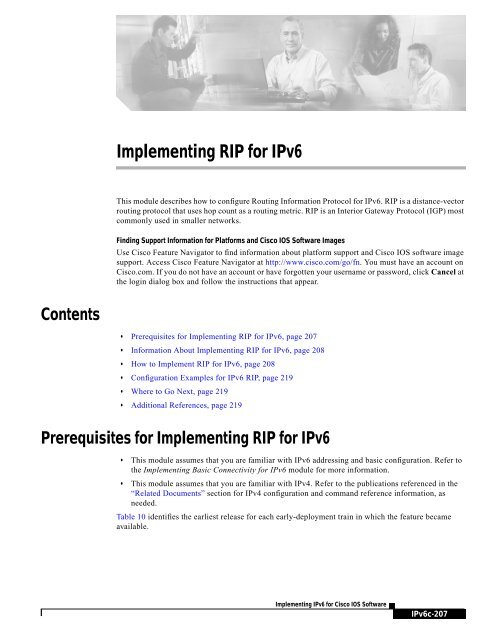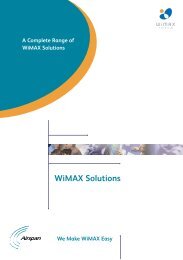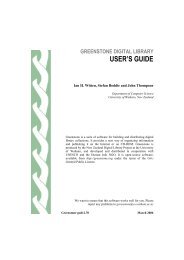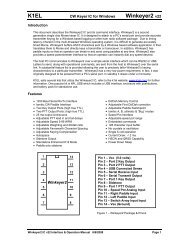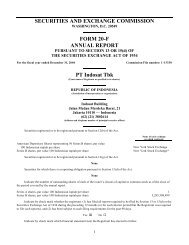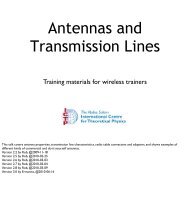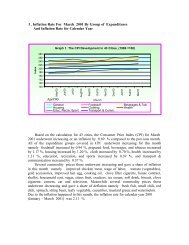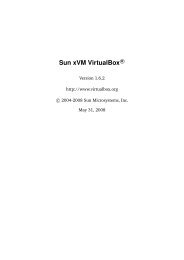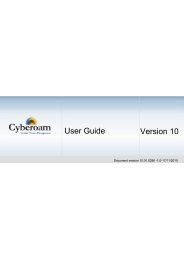Implementing RIP for IPv6 - Kambing UI
Implementing RIP for IPv6 - Kambing UI
Implementing RIP for IPv6 - Kambing UI
Create successful ePaper yourself
Turn your PDF publications into a flip-book with our unique Google optimized e-Paper software.
Contents<br />
<strong>Implementing</strong> <strong>RIP</strong> <strong>for</strong> <strong>IPv6</strong><br />
This module describes how to configure Routing In<strong>for</strong>mation Protocol <strong>for</strong> <strong>IPv6</strong>. <strong>RIP</strong> is a distance-vector<br />
routing protocol that uses hop count as a routing metric. <strong>RIP</strong> is an Interior Gateway Protocol (IGP) most<br />
commonly used in smaller networks.<br />
Finding Support In<strong>for</strong>mation <strong>for</strong> Plat<strong>for</strong>ms and Cisco IOS Software Images<br />
Use Cisco Feature Navigator to find in<strong>for</strong>mation about plat<strong>for</strong>m support and Cisco IOS software image<br />
support. Access Cisco Feature Navigator at http://www.cisco.com/go/fn. You must have an account on<br />
Cisco.com. If you do not have an account or have <strong>for</strong>gotten your username or password, click Cancel at<br />
the login dialog box and follow the instructions that appear.<br />
• Prerequisites <strong>for</strong> <strong>Implementing</strong> <strong>RIP</strong> <strong>for</strong> <strong>IPv6</strong>, page 207<br />
• In<strong>for</strong>mation About <strong>Implementing</strong> <strong>RIP</strong> <strong>for</strong> <strong>IPv6</strong>, page 208<br />
• How to Implement <strong>RIP</strong> <strong>for</strong> <strong>IPv6</strong>, page 208<br />
• Configuration Examples <strong>for</strong> <strong>IPv6</strong> <strong>RIP</strong>, page 219<br />
• Where to Go Next, page 219<br />
• Additional References, page 219<br />
Prerequisites <strong>for</strong> <strong>Implementing</strong> <strong>RIP</strong> <strong>for</strong> <strong>IPv6</strong><br />
• This module assumes that you are familiar with <strong>IPv6</strong> addressing and basic configuration. Refer to<br />
the <strong>Implementing</strong> Basic Connectivity <strong>for</strong> <strong>IPv6</strong> module <strong>for</strong> more in<strong>for</strong>mation.<br />
• This module assumes that you are familiar with IPv4. Refer to the publications referenced in the<br />
“Related Documents” section <strong>for</strong> IPv4 configuration and command reference in<strong>for</strong>mation, as<br />
needed.<br />
Table 10 identifies the earliest release <strong>for</strong> each early-deployment train in which the feature became<br />
available.<br />
<strong>Implementing</strong> <strong>IPv6</strong> <strong>for</strong> Cisco IOS Software<br />
<strong>IPv6</strong>c-207
In<strong>for</strong>mation About <strong>Implementing</strong> <strong>RIP</strong> <strong>for</strong> <strong>IPv6</strong><br />
In<strong>for</strong>mation About <strong>Implementing</strong> <strong>RIP</strong> <strong>for</strong> <strong>IPv6</strong><br />
<strong>RIP</strong> <strong>for</strong> <strong>IPv6</strong><br />
<strong>IPv6</strong>c-208<br />
Table 10 Minimum Required Cisco IOS Release<br />
To configure <strong>IPv6</strong> <strong>RIP</strong>, you need to understand the following concept:<br />
• <strong>RIP</strong> <strong>for</strong> <strong>IPv6</strong>, page 208<br />
<strong>Implementing</strong> <strong>IPv6</strong> <strong>for</strong> Cisco IOS Software<br />
<strong>Implementing</strong> <strong>RIP</strong> <strong>for</strong> <strong>IPv6</strong><br />
Minimum Required Cisco IOS Release<br />
Feature<br />
by Release Train<br />
<strong>RIP</strong> enhancements <strong>for</strong> <strong>IPv6</strong> 12.2(2)T, 12.0(21)ST, 12.0(22)S, 12.2(14)S, 12.3,<br />
12.3(2)T, 12.4, 12.4(2)T, 12.2(27)SBC<br />
Route redistribution 12.2(2)T, 12.0(21)ST, 12.0(22)S, 12.2(14)S, 12.3,<br />
12.3(2)T, 12.4, 12.4(2)T, 12.2(27)SBC<br />
<strong>IPv6</strong> <strong>RIP</strong> functions the same and offers the same benefits as <strong>RIP</strong> in IPv4. <strong>RIP</strong> enhancements <strong>for</strong> <strong>IPv6</strong>,<br />
detailed in RFC 2080, include support <strong>for</strong> <strong>IPv6</strong> addresses and prefixes, and the use of the all-<strong>RIP</strong>-routers<br />
multicast group address FF02::9 as the destination address <strong>for</strong> <strong>RIP</strong> update messages. New commands<br />
specific to <strong>RIP</strong> in <strong>IPv6</strong> were also added to the Cisco IOS command-line interface (CLI).<br />
In the Cisco IOS software implementation of <strong>IPv6</strong> <strong>RIP</strong> each <strong>IPv6</strong> <strong>RIP</strong> process maintains a local routing<br />
table, referred to as a Routing In<strong>for</strong>mation Database (RIB). The <strong>IPv6</strong> <strong>RIP</strong> RIB contains a set of best-cost<br />
<strong>IPv6</strong> <strong>RIP</strong> routes learned from all its neighboring networking devices. If <strong>IPv6</strong> <strong>RIP</strong> learns the same route<br />
from two different neighbors, but with different costs, it will store only the lowest cost route in the local<br />
RIB. The RIB also stores any expired routes that the <strong>RIP</strong> process is advertising to its neighbors running<br />
<strong>RIP</strong>. <strong>IPv6</strong> <strong>RIP</strong> will try to insert every non-expired route from its local RIB into the master <strong>IPv6</strong> RIB. If<br />
the same route has been learned from a different routing protocol with a better administrative distance<br />
than <strong>IPv6</strong> <strong>RIP</strong>, the <strong>RIP</strong> route will not be added to the <strong>IPv6</strong> RIB but the <strong>RIP</strong> route will still exist in the<br />
<strong>IPv6</strong> <strong>RIP</strong> RIB.<br />
How to Implement <strong>RIP</strong> <strong>for</strong> <strong>IPv6</strong><br />
When configuring supported routing protocols in <strong>IPv6</strong>, you must create the routing process, enable the<br />
routing process on interfaces, and customize the routing protocol <strong>for</strong> your particular network.<br />
Note The following sections describe the configuration tasks <strong>for</strong> creating an <strong>IPv6</strong> <strong>RIP</strong> routing process and<br />
enabling the routing process on interfaces. The following sections do not provide in-depth in<strong>for</strong>mation<br />
on customizing <strong>RIP</strong> because the protocol functions the same in <strong>IPv6</strong> as it does in IPv4. Refer to the<br />
publications referenced in the “Related Documents” section <strong>for</strong> further <strong>IPv6</strong> and IPv4 configuration and<br />
command reference in<strong>for</strong>mation.
<strong>Implementing</strong> <strong>RIP</strong> <strong>for</strong> <strong>IPv6</strong><br />
Enabling <strong>IPv6</strong> <strong>RIP</strong><br />
Prerequisites<br />
SUMMARY STEPS<br />
DETAILED STEPS<br />
Step 1 enable<br />
<strong>Implementing</strong> <strong>IPv6</strong> <strong>for</strong> Cisco IOS Software<br />
How to Implement <strong>RIP</strong> <strong>for</strong> <strong>IPv6</strong><br />
The tasks in the following sections explain how to configure <strong>IPv6</strong> <strong>RIP</strong>. Each task in the list is identified<br />
as either required or optional:<br />
This section contains the following procedures:<br />
• Enabling <strong>IPv6</strong> <strong>RIP</strong>, page 209 (required)<br />
• Customizing <strong>IPv6</strong> <strong>RIP</strong>, page 210 (optional)<br />
• Redistributing Routes into an <strong>IPv6</strong> <strong>RIP</strong> Routing Process, page 211 (optional)<br />
• Configuring Tags <strong>for</strong> <strong>RIP</strong> Routes, page 212 (optional)<br />
• Filtering <strong>IPv6</strong> <strong>RIP</strong> Routing Updates, page 213 (optional)<br />
• Verifying <strong>IPv6</strong> <strong>RIP</strong> Configuration and Operation, page 215 (optional)<br />
This task explains how to create an <strong>IPv6</strong> <strong>RIP</strong> process and enable the specified <strong>IPv6</strong> <strong>RIP</strong> process on an<br />
interface.<br />
Be<strong>for</strong>e configuring the router to run <strong>IPv6</strong> <strong>RIP</strong>, globally enable <strong>IPv6</strong> using the ipv6 unicast-routing<br />
global configuration command, and enable <strong>IPv6</strong> on any interfaces on which <strong>IPv6</strong> <strong>RIP</strong> is to be enabled.<br />
For details on basic <strong>IPv6</strong> connectivity tasks, refer to the <strong>Implementing</strong> Basic Connectivity <strong>for</strong> <strong>IPv6</strong><br />
module.<br />
1. enable<br />
2. configure terminal<br />
3. interface type number<br />
4. ipv6 rip name enable<br />
Command or Action Purpose<br />
Example:<br />
Router> enable<br />
Step 2 configure terminal<br />
Example:<br />
Router# configure terminal<br />
Enables privileged EXEC mode.<br />
• Enter your password if prompted.<br />
Enters global configuration mode.<br />
<strong>IPv6</strong>c-209
How to Implement <strong>RIP</strong> <strong>for</strong> <strong>IPv6</strong><br />
Step 3 interface type number<br />
Customizing <strong>IPv6</strong> <strong>RIP</strong><br />
SUMMARY STEPS<br />
DETAILED STEPS<br />
Example:<br />
Router(config)# interface Ethernet 0/0<br />
Step 4 ipv6 rip name enable<br />
Step 1 enable<br />
Command or Action Purpose<br />
Example:<br />
Router(config-if)# ipv6 rip process1 enable<br />
<strong>IPv6</strong>c-210<br />
<strong>Implementing</strong> <strong>IPv6</strong> <strong>for</strong> Cisco IOS Software<br />
<strong>Implementing</strong> <strong>RIP</strong> <strong>for</strong> <strong>IPv6</strong><br />
If you want to set or change a global value, follow steps 1 and 2, and then use the optional ipv6 router<br />
rip name command in global configuration mode.<br />
This optional task explains how to configure the maximum numbers of equal-cost paths that <strong>IPv6</strong> <strong>RIP</strong><br />
will support, adjust the <strong>IPv6</strong> <strong>RIP</strong> timers, and originate a default <strong>IPv6</strong> route.<br />
1. enable<br />
2. configure terminal<br />
3. ipv6 router rip name<br />
4. maximum-paths number-paths<br />
5. exit<br />
6. interface type number<br />
Specifies the interface type and number, and enters interface<br />
configuration mode.<br />
Enables the specified <strong>IPv6</strong> <strong>RIP</strong> routing process on an<br />
interface.<br />
7. ipv6 rip name default-in<strong>for</strong>mation {only | originate} [metric metric-value]<br />
Command or Action Purpose<br />
Example:<br />
Router> enable<br />
Step 2 configure terminal<br />
Example:<br />
Router# configure terminal<br />
Step 3 ipv6 router rip name<br />
Example:<br />
Router(config)# ipv6 router rip cisco<br />
Enables privileged EXEC mode.<br />
• Enter your password if prompted.<br />
Enters global configuration mode.<br />
Configures an <strong>IPv6</strong> <strong>RIP</strong> routing process and enters router<br />
configuration mode <strong>for</strong> the <strong>IPv6</strong> <strong>RIP</strong> routing process.<br />
• Use the name argument to identify a specific <strong>IPv6</strong> <strong>RIP</strong><br />
routing process.
<strong>Implementing</strong> <strong>RIP</strong> <strong>for</strong> <strong>IPv6</strong><br />
Redistributing Routes into an <strong>IPv6</strong> <strong>RIP</strong> Routing Process<br />
<strong>Implementing</strong> <strong>IPv6</strong> <strong>for</strong> Cisco IOS Software<br />
How to Implement <strong>RIP</strong> <strong>for</strong> <strong>IPv6</strong><br />
Command or Action Purpose<br />
Step 4 maximum-paths number-paths<br />
(Optional) Defines the maximum number of equal-cost<br />
routes that <strong>IPv6</strong> <strong>RIP</strong> can support.<br />
Step 5 exit<br />
Example:<br />
Router(config-router)# maximum-paths 1<br />
Example:<br />
Router(config-if)# exit<br />
Step 6 interface type number<br />
Example:<br />
Router(config)# interface Ethernet 0/0<br />
Step 7 ipv6 rip name default-in<strong>for</strong>mation {only |<br />
originate} [metric metric-value]<br />
Example:<br />
Router(config-if)# ipv6 rip cisco<br />
default-in<strong>for</strong>mation originate<br />
• The number-paths argument is an integer from 1 to 64.<br />
The default <strong>for</strong> <strong>RIP</strong> is four paths.<br />
Exits interface configuration mode and enters global<br />
configuration mode.<br />
Specifies the interface type and number, and enters interface<br />
configuration mode.<br />
(Optional) Originates the <strong>IPv6</strong> default route (::/0) into the<br />
specified <strong>RIP</strong> routing process updates sent out of the<br />
specified interface.<br />
Note To avoid routing loops after the <strong>IPv6</strong> default route<br />
(::/0) is originated out of any interface, the routing<br />
process ignores all default routes received on any<br />
interface.<br />
• Specifying the only keyword originates the default<br />
route (::/0) but suppresses all other routes in the updates<br />
sent on this interface.<br />
• Specifying the originate keyword originates the default<br />
route (::/0) in addition to all other routes in the updates<br />
sent on this interface.<br />
<strong>RIP</strong> supports the use of a route map to select routes <strong>for</strong> redistribution. Routes may be specified by prefix,<br />
using a route-map prefix list, or by tag, using the route-map “match tag” function.<br />
The maximum metric that <strong>RIP</strong> can advertise is 16, and a metric of 16 denotes a route that is unreachable.<br />
There<strong>for</strong>e, if you are redistributing routes with metrics greater than or equal to 16, then by default <strong>RIP</strong><br />
will advertise them as unreachable. These routes will not be used by neighboring routers. The user must<br />
configure a redistribution metric of less than 15 <strong>for</strong> these routes.<br />
Note You must to advertise a route with metric of 15 or less. A <strong>RIP</strong> router always adds an interface cost—the<br />
default is 1—onto the metric of a received route. If you advertise a route with metric 15, your neighbor<br />
will add 1 to it, making a metric of 16. Because a metric of 16 is unreachable, your neighbor will not<br />
install the route in the routing table.<br />
If no metric is specified, then the current metric of the route is used. To find the current metric of the<br />
route, enter the show ipv6 route command.<br />
This task explains how to redistribute tagged routes into an <strong>IPv6</strong> <strong>RIP</strong> routing process.<br />
<strong>IPv6</strong>c-211
How to Implement <strong>RIP</strong> <strong>for</strong> <strong>IPv6</strong><br />
SUMMARY STEPS<br />
DETAILED STEPS<br />
Step 1 enable<br />
<strong>IPv6</strong>c-212<br />
1. enable<br />
2. configure terminal<br />
3. interface type number<br />
4. ipv6 rip word enable<br />
<strong>Implementing</strong> <strong>IPv6</strong> <strong>for</strong> Cisco IOS Software<br />
<strong>Implementing</strong> <strong>RIP</strong> <strong>for</strong> <strong>IPv6</strong><br />
5. redistribute protocol [process-id]{level-1 | level-1-2 | level-2}[metric metric-value][metric-type<br />
{internal | external}] [route-map map-name]<br />
Command or Action Purpose<br />
Example:<br />
Router> enable<br />
Step 2 configure terminal<br />
Example:<br />
Router# configure terminal<br />
Step 3 interface type number<br />
Example:<br />
Router(config)# interface Ethernet 0/0<br />
Step 4 ipv6 rip word enable<br />
Example:<br />
Router(config-if)# ipv6 router one enable<br />
Step 5 redistribute protocol [process-id] {level-1 |<br />
level-1-2 | level-2} [metric metric-value]<br />
[metric-type {internal | external}] [route-map<br />
map-name]<br />
Example:<br />
Router(config-router)# redistribute bgp 65001<br />
route-map bgp-to-rip<br />
Configuring Tags <strong>for</strong> <strong>RIP</strong> Routes<br />
Enables privileged EXEC mode.<br />
• Enter your password if prompted.<br />
Enters global configuration mode.<br />
Specifies the interface type and number, and enters interface<br />
configuration mode.<br />
Enables an <strong>IPv6</strong> Routing In<strong>for</strong>mation Protocol (<strong>RIP</strong>)<br />
routing process on an interface.<br />
Redistributes the specified routes into the <strong>IPv6</strong> <strong>RIP</strong> routing<br />
process.<br />
• The protocol argument can be one of the following<br />
keywords: bgp, connected, isis, rip, or static.<br />
• The rip keyword and process-id argument specify an<br />
<strong>IPv6</strong> <strong>RIP</strong> routing process.<br />
Note The connected keyword refers to routes that are<br />
established automatically by assigning <strong>IPv6</strong><br />
addresses to an interface.<br />
When per<strong>for</strong>ming route redistribution, you can associate a numeric tag with a route. The tag is advertised<br />
with the route by <strong>RIP</strong> and will be installed along with the route in neighboring router’s routing table.
<strong>Implementing</strong> <strong>RIP</strong> <strong>for</strong> <strong>IPv6</strong><br />
SUMMARY STEPS<br />
DETAILED STEPS<br />
Step 1 enable<br />
<strong>Implementing</strong> <strong>IPv6</strong> <strong>for</strong> Cisco IOS Software<br />
How to Implement <strong>RIP</strong> <strong>for</strong> <strong>IPv6</strong><br />
If you redistribute a tagged route (<strong>for</strong> example, a route in the <strong>IPv6</strong> routing table that already has a tag)<br />
into <strong>RIP</strong>, then <strong>RIP</strong> will automatically advertise the tag with the route. If you use a redistribution route<br />
map to specify a tag, then <strong>RIP</strong> will use the route map tag in preference to the routing table tag.<br />
The following task explains how to set route tags using a route map.<br />
1. enable<br />
2. configure terminal<br />
3. route-map map-tag [permit | deny] [sequence-number]<br />
4. match ipv6 address {prefix-list prefix-list-name | access-list-name}<br />
5. set tag value<br />
Command or Action Purpose<br />
Example:<br />
Router> enable<br />
Step 2 configure terminal<br />
Example:<br />
Router# configure terminal<br />
Step 3 route-map map-tag [permit | deny]<br />
[sequence-number]<br />
Example:<br />
Router(config)# route-map bgp-to-rip permit 10<br />
Step 4 match ipv6 address {prefix-list<br />
prefix-list-name | access-list-name}<br />
Example:<br />
Router(config-route-map)# match ipv6 address<br />
prefix-list bgp-to-rip-flt<br />
Step 5 set tag value<br />
Example:<br />
Router(config-route-map)# set tag 4<br />
Filtering <strong>IPv6</strong> <strong>RIP</strong> Routing Updates<br />
Enables privileged EXEC mode.<br />
• Enter your password if prompted.<br />
Enters global configuration mode.<br />
Defines a route map, and enters route-map configuration<br />
mode.<br />
• Follow this step with a match command.<br />
Specifies a list of <strong>IPv6</strong> prefixes to be matched.<br />
Sets the tag value to associate with the redistributed routes.<br />
Route filtering using distribute lists provides control over the routes <strong>RIP</strong> receives and advertises. This<br />
control may be exercised globally or per interface.<br />
<strong>IPv6</strong>c-213
How to Implement <strong>RIP</strong> <strong>for</strong> <strong>IPv6</strong><br />
<strong>IPv6</strong> Distribute Lists<br />
<strong>IPv6</strong>c-214<br />
<strong>Implementing</strong> <strong>IPv6</strong> <strong>for</strong> Cisco IOS Software<br />
<strong>Implementing</strong> <strong>RIP</strong> <strong>for</strong> <strong>IPv6</strong><br />
This task explains how to apply a prefix list to <strong>IPv6</strong> <strong>RIP</strong> routing updates that are received or sent on an<br />
interface.<br />
Filtering is controlled by distribute lists. Input distribute lists control route reception, and input filtering<br />
is applied to advertisements received from neighbors. Only those routes that pass input filtering will be<br />
inserted in the <strong>RIP</strong> local routing table and become candidates <strong>for</strong> insertion into the <strong>IPv6</strong> routing table.<br />
Output distribute lists control route advertisement; Output filtering is applied to route advertisements<br />
sent to neighbors. Only those routes passing output filtering will be advertised.<br />
Global distribute lists (which are distribute lists that do not apply to a specified interface) apply to all<br />
interfaces. If a distribute list specifies an interface, then that distribute list applies only to that interface.<br />
An interface distribute list always takes precedence. For example, <strong>for</strong> a route received at an interface,<br />
with the interface filter set to deny, and the global filter set to permit, the route is blocked, the interface<br />
filter is passed, the global filter is blocked, and the route is passed.<br />
<strong>IPv6</strong> Prefix List Operand Keywords<br />
SUMMARY STEPS<br />
<strong>IPv6</strong> prefix lists are used to specify certain prefixes or a range of prefixes that must be matched be<strong>for</strong>e<br />
a permit or deny statement can be applied. Two operand keywords can be used to designate a range of<br />
prefix lengths to be matched. A prefix length of less than, or equal to, a value is configured with the le<br />
keyword. A prefix length greater than, or equal to, a value is specified using the ge keyword. The ge and<br />
le keywords can be used to specify the range of the prefix length to be matched in more detail than the<br />
usual ipv6-prefix/prefix-length argument. For a candidate prefix to match against a prefix list entry three<br />
conditions can exist:<br />
• The candidate prefix must match the specified prefix list and prefix length entry.<br />
• The value of the optional le keyword specifies the range of allowed prefix lengths from the<br />
prefix-length argument up to, and including, the value of the le keyword.<br />
• The value of the optional ge keyword specifies the range of allowed prefix lengths from the value of<br />
the ge keyword up to, and including, 128.<br />
Note Note that the first condition must match be<strong>for</strong>e the other conditions take effect.<br />
An exact match is assumed when the ge or le keywords are not specified. If only one keyword operand<br />
is specified then the condition <strong>for</strong> that keyword is applied, and the other condition is not applied. The<br />
prefix-length value must be less than the ge value. The ge value must be less than, or equal to, the le<br />
value. The le value must be less than or equal to 128.<br />
1. enable<br />
2. configure terminal<br />
3. ipv6 prefix list prefix-list-name [seq seq-number] {deny ipv6-prefix/prefix-length | description<br />
text} [ge ge-value] [le le-value]<br />
4. ipv6 prefix list prefix-list-name [seq seq-number] {permit ipv6-prefix/prefix-length | description<br />
text} [ge ge-value] [le le-value]<br />
5. Repeat Steps 3 and 4 as many times as necessary to build the prefix list.
<strong>Implementing</strong> <strong>RIP</strong> <strong>for</strong> <strong>IPv6</strong><br />
DETAILED STEPS<br />
Step 1 enable<br />
6. ipv6 router rip name<br />
<strong>Implementing</strong> <strong>IPv6</strong> <strong>for</strong> Cisco IOS Software<br />
How to Implement <strong>RIP</strong> <strong>for</strong> <strong>IPv6</strong><br />
7. distribute-list prefix-list prefix-list-name {in | out} [interface-type interface-number]<br />
Command or Action Purpose<br />
Example:<br />
Router> enable<br />
Step 2 configure terminal<br />
Example:<br />
Router# configure terminal<br />
Step 3 ipv6 prefix list prefix-list-name [seq<br />
seq-number] {deny ipv6-prefix/prefix-length |<br />
description text} [ge ge-value] [le le-value]<br />
Example:<br />
Router(config)# ipv6 prefix-list abc permit<br />
2001:0db8::/16<br />
Step 4 ipv6 prefix list prefix-list-name [seq<br />
seq-number] {deny ipv6-prefix/prefix-length |<br />
description text} [ge ge-value] [le le-value]<br />
Example:<br />
Router(config)# ipv6 prefix-list abc deny ::/0<br />
Step 5 Repeat Steps 3 and 4 as many times as necessary to<br />
build the prefix list.<br />
Step 6 ipv6 router rip name<br />
Example:<br />
Router(config)# ipv6 router rip cisco<br />
Step 7 distribute-list prefix-list prefix-list-name<br />
{in | out} [interface-type interface-number]<br />
Example:<br />
Router(config-rtr-rip)# distribute-list<br />
prefix-list cisco in ethernet 0/0<br />
Verifying <strong>IPv6</strong> <strong>RIP</strong> Configuration and Operation<br />
A user may want to check <strong>IPv6</strong> <strong>RIP</strong> configuration and operation. Some of the following scenarios may<br />
occur <strong>for</strong> which a user can then enable the following show and debug commands:<br />
• “Why isn’t a certain route appearing in my <strong>IPv6</strong> routing table?”<br />
• “Am I receiving routes via <strong>RIP</strong>?”<br />
Enables privileged EXEC mode.<br />
• Enter your password if prompted.<br />
Enters global configuration mode.<br />
Creates an entry in the <strong>IPv6</strong> prefix list.<br />
Creates an entry in the <strong>IPv6</strong> prefix list.<br />
—<br />
Configures an <strong>IPv6</strong> <strong>RIP</strong> routing process.<br />
Applies a prefix list to <strong>IPv6</strong> <strong>RIP</strong> routing updates that are<br />
received or sent on an interface.<br />
<strong>IPv6</strong>c-215
How to Implement <strong>RIP</strong> <strong>for</strong> <strong>IPv6</strong><br />
SUMMARY STEPS<br />
DETAILED STEPS<br />
Output Examples<br />
<strong>IPv6</strong>c-216<br />
• “Is a certain route being filtered?”<br />
<strong>Implementing</strong> <strong>IPv6</strong> <strong>for</strong> Cisco IOS Software<br />
<strong>Implementing</strong> <strong>RIP</strong> <strong>for</strong> <strong>IPv6</strong><br />
• “Someone at a route site told me that I am not advertising a certain route. True?”<br />
This task explains how to display in<strong>for</strong>mation to verify the configuration and operation of <strong>IPv6</strong> <strong>RIP</strong>.<br />
1. show ipv6 rip [name] [database | next-hops]<br />
2. show ipv6 route [ipv6-address | ipv6-prefix/prefix-length | protocol]<br />
3. enable<br />
4. debug ipv6 rip [interface-type interface-number]<br />
Command or Action Purpose<br />
Step 1 show ipv6 rip [name] [database | next-hops]<br />
Example:<br />
Router> show ipv6 rip cisco database<br />
Step 2 show ipv6 route [ipv6-address |<br />
ipv6-prefix/prefix-length | protocol]<br />
Step 3 enable<br />
Example:<br />
Router> show ipv6 route rip<br />
Example:<br />
Router> enable<br />
Step 4 debug ipv6 rip [interface-type<br />
interface-number]<br />
Example:<br />
Router# debug ipv6 rip<br />
This section provides the following output examples:<br />
• Sample Output <strong>for</strong> the show ipv6 rip Command, page 217<br />
• Sample Output <strong>for</strong> the show ipv6 route Command, page 218<br />
• Sample Output <strong>for</strong> the debug ipv6 rip Command, page 218<br />
(Optional) Displays in<strong>for</strong>mation about current <strong>IPv6</strong> <strong>RIP</strong><br />
processes.<br />
• In this example, <strong>IPv6</strong> <strong>RIP</strong> process database in<strong>for</strong>mation<br />
is displayed <strong>for</strong> the specified <strong>IPv6</strong> <strong>RIP</strong> process.<br />
(Optional) Displays the current contents of the <strong>IPv6</strong> routing<br />
table.<br />
• In this example, only <strong>IPv6</strong> <strong>RIP</strong> routes are displayed.<br />
Enables higher privilege levels, such as privileged EXEC<br />
mode.<br />
• Enter your password if prompted.<br />
(Optional) Displays debugging messages <strong>for</strong> <strong>IPv6</strong> <strong>RIP</strong><br />
routing transactions.
<strong>Implementing</strong> <strong>RIP</strong> <strong>for</strong> <strong>IPv6</strong><br />
Sample Output <strong>for</strong> the show ipv6 rip Command<br />
<strong>Implementing</strong> <strong>IPv6</strong> <strong>for</strong> Cisco IOS Software<br />
How to Implement <strong>RIP</strong> <strong>for</strong> <strong>IPv6</strong><br />
In the following example, output in<strong>for</strong>mation about all current <strong>IPv6</strong> <strong>RIP</strong> processes is displayed using the<br />
show ipv6 rip user EXEC command:<br />
Router> show ipv6 rip<br />
<strong>RIP</strong> process "cisco", port 521, multicast-group FF02::9, pid 62<br />
Administrative distance is 120. Maximum paths is 1<br />
Updates every 5 seconds, expire after 15<br />
Holddown lasts 10 seconds, garbage collect after 30<br />
Split horizon is on; poison reverse is off<br />
Default routes are generated<br />
Periodic updates 223, trigger updates 1<br />
Interfaces:<br />
Ethernet0/0<br />
Redistribution:<br />
Redistributing protocol bgp 65001 route-map bgp-to-rip<br />
In the following example, output in<strong>for</strong>mation about a specified <strong>IPv6</strong> <strong>RIP</strong> process database is displayed<br />
using the show ipv6 rip user EXEC command with the name argument and the database keyword. In<br />
the following output <strong>for</strong> the <strong>IPv6</strong> <strong>RIP</strong> process named cisco, timer in<strong>for</strong>mation is displayed, and route<br />
2001:0db8::16/64 has a route tag set:<br />
Router> show ipv6 rip cisco database<br />
<strong>RIP</strong> process "cisco", local RIB<br />
2001:0db8::/64, metric 2<br />
Ethernet0/0/FE80::A8BB:CCFF:FE00:B00, expires in 13 secs<br />
2001:0db8::/16, metric 2 tag 4, installed<br />
Ethernet0/0/FE80::A8BB:CCFF:FE00:B00, expires in 13 secs<br />
2001:0db8:1::/16, metric 2 tag 4, installed<br />
Ethernet0/0/FE80::A8BB:CCFF:FE00:B00, expires in 13 secs<br />
2001:0db8:2::/16, metric 2 tag 4, installed<br />
Ethernet0/0/FE80::A8BB:CCFF:FE00:B00, expires in 13 secs<br />
::/0, metric 2, installed<br />
Ethernet0/0/FE80::A8BB:CCFF:FE00:B00, expires in 13 secs<br />
In the following example, output in<strong>for</strong>mation <strong>for</strong> a specified <strong>IPv6</strong> <strong>RIP</strong> process is displayed using the<br />
show ipv6 rip user EXEC command with the name argument and the next-hops keyword:<br />
Router> show ipv6 rip cisco next-hops<br />
<strong>RIP</strong> process "cisco", Next Hops<br />
FE80::A8BB:CCFF:FE00:A00/Ethernet0/0 [4 paths]<br />
Note For a description of each output display field, refer to the show ipv6 rip command in the <strong>IPv6</strong> <strong>for</strong><br />
Cisco IOS Command Reference.<br />
<strong>IPv6</strong>c-217
How to Implement <strong>RIP</strong> <strong>for</strong> <strong>IPv6</strong><br />
Sample Output <strong>for</strong> the show ipv6 route Command<br />
<strong>IPv6</strong>c-218<br />
<strong>Implementing</strong> <strong>IPv6</strong> <strong>for</strong> Cisco IOS Software<br />
<strong>Implementing</strong> <strong>RIP</strong> <strong>for</strong> <strong>IPv6</strong><br />
The current metric of the route can be found by entering the show ipv6 route command. In the following<br />
example, output in<strong>for</strong>mation <strong>for</strong> all <strong>IPv6</strong> <strong>RIP</strong> routes is displayed using the show ipv6 route user EXEC<br />
command with the rip protocol keyword:<br />
Router> show ipv6 route rip<br />
<strong>IPv6</strong> Routing Table - 17 entries<br />
Codes: C - Connected, L - Local, S - Static, R - <strong>RIP</strong>, B - BGP<br />
U - Per-user Static route<br />
I1 - ISIS L1, I2 - ISIS L2, IA - ISIS interarea<br />
O - OSPF intra, OI - OSPF inter, OE1 - OSPF ext 1, OE2 - OSPF ext 2<br />
R 2001:0db8:1::/32 [120/2]<br />
via FE80::A8BB:CCFF:FE00:A00, Ethernet0/0<br />
R 2001:0db8:2::/32 [120/2]<br />
via FE80::A8BB:CCFF:FE00:A00, Ethernet0/0<br />
R 2001:0db8:3::/32 [120/2]<br />
via FE80::A8BB:CCFF:FE00:A00, Ethernet0/0<br />
Sample Output <strong>for</strong> the debug ipv6 rip Command<br />
In the following example, debugging messages <strong>for</strong> <strong>IPv6</strong> <strong>RIP</strong> routing transactions are displayed using the<br />
debug ipv6 rip privileged EXEC command:<br />
Note By default, the system sends the output from debug commands and system error messages to the<br />
console. To redirect debugging output, use the logging command options within privileged EXEC mode.<br />
Possible destinations include the console, virtual terminals, internal buffer, and UNIX hosts running a<br />
syslog server. For complete in<strong>for</strong>mation on debug commands and redirecting debugging output, refer to<br />
the Cisco IOS Debug Command Reference, Release 12.4.<br />
Router# debug ipv6 rip<br />
<strong>RIP</strong>ng: Sending multicast update on Ethernet0/0 <strong>for</strong> cisco<br />
src=FE80::A8BB:CCFF:FE00:B00<br />
dst=FF02::9 (Ethernet0/0)<br />
sport=521, dport=521, length=112<br />
command=2, version=1, mbz=0, #rte=5<br />
tag=0, metric=1, prefix=2001:0db8::/64<br />
tag=4, metric=1, prefix=2001:0db8:1::/16<br />
tag=4, metric=1, prefix=2001:0db8:2;:/16<br />
tag=4, metric=1, prefix=2001:0db8:3::/16<br />
tag=0, metric=1, prefix=::/0<br />
<strong>RIP</strong>ng: Next RIB walk in 10032<br />
<strong>RIP</strong>ng: response received from FE80::A8BB:CCFF:FE00:A00 on Ethernet0/0 <strong>for</strong> cisco<br />
src=FE80::A8BB:CCFF:FE00:A00 (Ethernet0/0)<br />
dst=FF02::9<br />
sport=521, dport=521, length=92<br />
command=2, version=1, mbz=0, #rte=4<br />
tag=0, metric=1, prefix=2001:0db8::/64<br />
tag=0, metric=1, prefix=2001:0db8:1::/32<br />
tag=0, metric=1, prefix=2001:0db8:2::/32<br />
tag=0, metric=1, prefix=2001:0db8:3::/32
<strong>Implementing</strong> <strong>RIP</strong> <strong>for</strong> <strong>IPv6</strong><br />
Configuration Examples <strong>for</strong> <strong>IPv6</strong> <strong>RIP</strong><br />
This section provides the following configuration examples:<br />
• <strong>IPv6</strong> <strong>RIP</strong> Configuration: Example, page 219<br />
<strong>IPv6</strong> <strong>RIP</strong> Configuration: Example<br />
Where to Go Next<br />
<strong>Implementing</strong> <strong>IPv6</strong> <strong>for</strong> Cisco IOS Software<br />
Configuration Examples <strong>for</strong> <strong>IPv6</strong> <strong>RIP</strong><br />
In the following example, the <strong>IPv6</strong> <strong>RIP</strong> process named cisco is enabled on the router and on Ethernet<br />
interface 0/0. The <strong>IPv6</strong> default route (::/0) is advertised in addition to all other routes in router updates<br />
sent on Ethernet interface 0/0. Additionally, BGP routes are redistributed into the <strong>RIP</strong> process named<br />
cisco according to a route map where routes that match a prefix list are also tagged. The number of<br />
parallel paths is set to one to allow the route tagging, and the <strong>IPv6</strong> <strong>RIP</strong> timers are adjusted. A prefix list<br />
named eth0/0-in-flt filters inbound routing updates on Ethernet interface 0/0.<br />
ipv6 router rip cisco<br />
maximum-paths 1<br />
redistribute bgp 65001 route-map bgp-to-rip<br />
distribute-list prefix-list eth0/0-in-flt in Ethernet0/0<br />
!<br />
interface Ethernet0/0<br />
ipv6 address 2001:0db8::/64 eui-64<br />
ipv6 rip cisco enable<br />
ipv6 rip cisco default-in<strong>for</strong>mation originate<br />
!<br />
ipv6 prefix-list bgp-to-rip-flt seq 10 deny 2001:0db8:3::/16 le 128<br />
ipv6 prefix-list bgp-to-rip-flt seq 20 permit 2001:0db8:1::/8 le 128<br />
!<br />
ipv6 prefix-list eth0/0-in-flt seq 10 deny ::/0<br />
ipv6 prefix-list eth0/0-in-flt seq 15 permit ::/0 le 128<br />
!<br />
route-map bgp-to-rip permit 10<br />
match ipv6 address prefix-list bgp-to-rip-flt<br />
set tag 4<br />
If you want to implement more <strong>IPv6</strong> routing protocols, see the <strong>Implementing</strong> IS-IS <strong>for</strong> <strong>IPv6</strong> or<br />
<strong>Implementing</strong> Multiprotocol BGP <strong>for</strong> <strong>IPv6</strong> module.<br />
Additional References<br />
For additional in<strong>for</strong>mation related to implementing <strong>RIP</strong> <strong>for</strong> <strong>IPv6</strong>, see the following sections:<br />
• Related Documents, page 220<br />
• Standards, page 220<br />
• MIBs, page 220<br />
• RFCs, page 220<br />
• Technical Assistance, page 220<br />
<strong>IPv6</strong>c-219
Additional References<br />
Related Documents<br />
Standards<br />
MIBs<br />
RFCs<br />
Technical Assistance<br />
<strong>IPv6</strong>c-220<br />
<strong>Implementing</strong> <strong>IPv6</strong> <strong>for</strong> Cisco IOS Software<br />
<strong>Implementing</strong> <strong>RIP</strong> <strong>for</strong> <strong>IPv6</strong><br />
Related Topic Document Title<br />
<strong>RIP</strong> configuration tasks “Configuring Routing In<strong>for</strong>mation Protocol” chapter in the Cisco<br />
IOS IP Configuration Guide, Release 12.4<br />
<strong>RIP</strong> commands: complete command syntax, command<br />
mode, defaults, usage guidelines, and examples<br />
Cisco IOS IP Command Reference, Volume 2 of 3: Routing<br />
Protocols, Release 12.4<br />
<strong>IPv6</strong> supported feature list Start Here: Cisco IOS Software Release Specifics <strong>for</strong> <strong>IPv6</strong> Features<br />
<strong>IPv6</strong> commands: complete command syntax, command<br />
mode, defaults, usage guidelines, and examples<br />
<strong>IPv6</strong> <strong>for</strong> Cisco IOS Command Reference<br />
IPv4 configuration and command reference<br />
in<strong>for</strong>mation<br />
Standards Title<br />
No new or modified standards are supported by this —<br />
feature, and support <strong>for</strong> existing standards has not been<br />
modified by this feature.<br />
MIBs MIBs Link<br />
No new or modified MIBs are supported by this<br />
feature, and support <strong>for</strong> existing MIBs has not been<br />
modified by this feature.<br />
RFCs Title<br />
RFC 2080 <strong>RIP</strong>ng <strong>for</strong> <strong>IPv6</strong><br />
Cisco IOS Release 12.4 Configuration Guides and Command<br />
References<br />
To locate and download MIBs <strong>for</strong> selected plat<strong>for</strong>ms, Cisco IOS<br />
releases, and feature sets, use Cisco MIB Locator found at the<br />
following URL:<br />
http://www.cisco.com/go/mibs<br />
Description Link<br />
The Cisco Technical Support website contains http://www.cisco.com/techsupport<br />
thousands of pages of searchable technical content,<br />
including links to products, technologies, solutions,<br />
technical tips, and tools. Registered Cisco.com users<br />
can log in from this page to access even more content.


